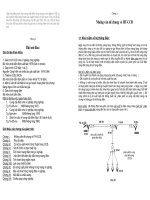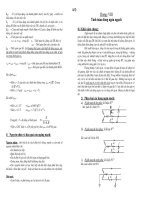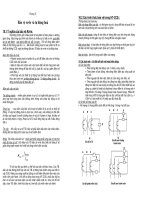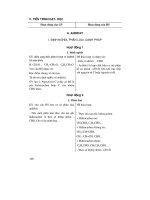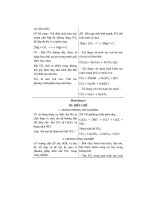Bài giảng môn học thí nghiệm cầu part 10 ppt
Bạn đang xem bản rút gọn của tài liệu. Xem và tải ngay bản đầy đủ của tài liệu tại đây (377.16 KB, 15 trang )
25
Figure 29 Measured and Computed Stresses - Floor Beam at Midspan.
Figure 30 Measured and Computed Stresses - Floor Beam at Quarter Span.
Bài giảng Thí nghiệm cầu - Page 154 of 168
26
Appendix A - Field Testing Procedures
The motivation for developing a relatively easy-to-implement field testing system
was to allow short and medium span bridges to be tested on a routine basis. Original
development of the hardware was started in 1988 at the University of Colorado under a
contract with the Pennsylvania Department of Transportation (PennDOT). Subsequent
to that project, the Integrated technique was refined on another study funded by the
Federal Highway Administration (FHWA) in which 35 bridges located on the Interstate
system throughout the country were tested and evaluated. Further refinement has been
implemented over the last several years through testing and evaluating several more
bridges, lock gates, and other structures.
The real key to being able to complete the field testing quickly is the use of strain
transducers (rather than standard foil strain gages) that can be attached to the
structural members in just a few minutes. These sensors were originally developed for
monitoring dynamic strains on foundation piles during the driving process. They have
been adapted for use in structural testing through special modifications, and have a 3 to
4 percent accuracy, and are periodically re-calibrated to NIST standards.
In addition to the strain sensors, the data acquisition hardware has been
designed specifically for field use through the use of rugged cables and military-style
connectors. This allows quick assembly of the system and keeps bookkeeping to a
minimum. The analog-to-digital converter (A/D) is an off-the-shelf-unit, but all signal
conditioning, amplification, and balancing hardware has been specially designed for
structural testing. The test software has been written to allow easy configuration (test
length, etc.) and operation. The end result is a system that can be used by people other
than computer experts or electrical engineers. Other enhancements include the use of
a remote-control position indicator. As the test vehicle crosses the structure, one of the
testing personnel walks along-side and depresses a button on the communication radio
each time the front axle of the vehicle crosses one of the chalk lines laid out on the
deck. This action sends a signal to the strain measurement system which receives it
and puts a mark in the data. This allows the field strains to be compared to analytical
strains as a function of vehicle position, not only as a function of time.
The use of a moving load as opposed to placing the truck at discrete locations
has two major benefits. First, the testing can be completed much quicker, meaning
there is less impact on traffic. Second, and more importantly, much more information
can be obtained (both quantitative and qualitative). Discontinuities or unusual
responses in the strain histories, which are often signs of distress, can be easily
detected. Since the load position is monitored as well, it is easy to determine what
loading conditions cause the observed effects. If readings are recorded only at discreet
truck locations, the risk of losing information between the points is great. The
advantages of continuous readings have been proven over and over again.
The following list of procedures have been reproduced from the BDI Structural
Testing System (STS) Operation Manual. This outline is intended to describe the general
procedures used for completing a successful field test on a highway bridge using the BDI-
STS. Other types of structures can be tested as well with only slight deviations from the
directions given here.
Bài giảng Thí nghiệm cầu - Page 155 of 168
27
Once a tentative instrumentation plan has been developed for the structure in
question, the strain transducers must be attached and the STS prepared for running the
test.
Attaching Strain Transducers
There are two methods for attaching the strain transducers to the structural
members: C-clamping or with tabs and adhesive. For steel structures, quite often the
transducers can be clamped directly to the steel flanges of rolled sections or plate girders.
If significant lateral bending is assumed to be present, then one transducer may be
clamped to each edge of the flange. If the transducer is to be clamped, insure that the
clamp is centered over the mounting holes. In general, the transducers can be clamped
directly to painted surfaces. However, if the surface being clamped to is rough or has very
thick paint, it should be cleaned first with a grinder. The alternative to clamping is the tab
attachment method outlined below.
1. Place two tabs in mounting jig. Place transducer over mounts and tighten the 1/4-20
nuts until they are snug (approximately 50 in-lb.). This procedure allows the tabs to
mounted without putting stress on the transducer itself. When attaching transducers to
R/C members, transducer extensions are used to obtain a longer gage length. In this
case the extension is bolted to one end of the transducer and the tabs are bolted to
the free ends of the transducer and the extension.
2. Mark the centerline of the transducer location on the structure. Place marks 1-1/2
inches on either side of the centerline and using a hand grinder, remove paint or scale
from these areas. If attaching to concrete, lightly grind the surface to remove any
scale. If the paint is quite thick, use a chisel to remove most of it before grinding.
3. Very lightly grind the bottom of the transducer tabs to remove any oxidation or other
contaminants.
4. Apply a thin line of adhesive to the bottom of each transducer tab.
5. Spray each tab and the contact area on the structural member with the adhesive
accelerator.
6. Mount transducer in its proper location and apply a light force to the tabs (not the
center of the transducer) for approximately 10 seconds.
If the above steps are followed, it should be possible to mount each transducer in
approximately five minutes. When the test is complete, carefully loosen the 1/4-20 nuts
from the tabs and remove transducer. If one is not careful, the tab will pop loose from the
structure and the transducer may be damaged. Use vice grips to remove the tabs from
the structure.
Bài giảng Thí nghiệm cầu - Page 156 of 168
28
allow four transducers to be plugged in. Each STS unit can be easily clamped to the
bridge girders. If the structure is concrete and no flanges are available to set the STS
units on, transducer tabs glued to the structure and plastic zip-ties or small wire can be
used to hold them up. Since the transducers will identify themselves to the system, there
is no special order that they must follow. The only information that must be recorded is
the transducer serial number and its location on the structure. Large cables are provided
which can be connected between the STS units. The maximum length between STS units
is 50ft (15m). If several gages are in close proximity to each other, then the STS units can
be plugged directly to each other without the use of a cable. All connectors will "click"
when the connection has been completed properly.
Once all of the STS units have been connected in series, one cable must be run
and connected to the power supply located near the PC. Connect the 9-pin serial cable
between the computer and the power supply. The position indicator is then assembled
and the system connected to a power source (either 12VDC or 120-240AC). The system
is now ready to acquire data.
Performing Load Test
The general testing sequence is as follows:
1. Transducers are mounted and the system is connected together and turned on.
2. The deck is marked out for each truck pass. Locate the point on the deck directly
above the first bearing for one of the fascia beams. If the bridge is skewed, the first
point encountered from the direction of travel is used and an imaginary line extended
across and normal to the roadway as shown in Figure 31. All tests are started from
this line. In order to track the position of the loading vehicle on the bridge during the
test, an X-Y coordinate system, with the origin at the selected reference point is laid
out. Longitudinal marks are placed with chalk powder the length of the bridge in even
increments. For spans less than 100-ft (30.5-m), 10-ft (3.05-m) increments are used,
although for very short spans, use 5-ft (1.5-m) For longer spans, marks are placed at
20-foot (6.1-m) intervals. This is done for each lane that the truck travels over. A
typical deck layout is shown in Figure 31.
In addition to monitoring the longitudinal position, the vehicle's transverse position
must be known. The transverse truck position is kept uniform by first aligning the truck
in the center of the lane where it would normally travel at highway speed. Next, a
chalk mark is made on the deck locating the transverse location of the driver's side
front wheel. By making a measurement from this mark to the reference point, the
transverse ("Y") position of the truck is always known. The truck is aligned on this
mark for all subsequent tests in this lane. For two lane bridges with shoulders, tests
are run on the shoulder (driver's side front wheel along the white line) and in the
center of each lane. If the bridge has only two lanes and very little shoulder, tests are
run in the center of each lane only. If the purpose of the test is to calibrate a computer
model, it is sometimes more convenient to simply use the lane lines as guides since it
Assembly of System
Once the transducers have been mounted, they should be connected into an STS
unit. The STS units should be placed near the transducer locations in such a manner to
Bài giảng Thí nghiệm cầu - Page 157 of 168
29
is easier for the driver to maintain a constant lateral position. Responses due to critical
truck positions are then obtained by the analysis.
The driver is instructed that the test vehicle must be kept in the proper location on
the bridge. For example, the left front wheel needs to be kept on the white line for the
shoulder tests. Another important item is that the vehicle maintain a constant rate of
speed during the entire test.
Two more pieces of information are then needed: the axle weights and dimensions
of the test vehicle. The axle weights are generally provided by the driver, who stops at
a local scale. However, a weight enforcement team can use portable scales and
weigh the truck at the bridge site. Wheel base and axle width dimensions are made
with a tape measure and recorded.
Figure 31 Typical Deck Layout for Load Position Monitoring
3. The program is started and the number of channels indicated is verified. If the number
of channels indicated do not match the number of channels actually there, a
malfunction has occurred and must be corrected before testing commences.
4. The transducers are initialized (zeroed out) with the Balance option. If a transducer
cannot be initialized, it should be inspected to ensure that it has not been damaged.
5. The desired test length, sample rate, and output file name are selected. In general, a
longer test time than the actual event is selected. For most bridge tests, a one or two-
minute test length will suffice since the test can be stopped as soon as the truck
crosses completely over the structure.
6. To facilitate presenting data as a function of load position, rather than time, two items
describing the PI information must be defined. The starting position and PI interval
distance allow the data to be plotted using position coordinates that are consistent
with a numeric analysis. The starting position refers to the longitudinal position of the
load vehicle in the model coordinate system when the data recording is started. The
interval distance(s) is the distance between position marks using the units and sign
convention of the coordinate system. Typically, all of the intervals are defined with the
Bài giảng Thí nghiệm cầu - Page 158 of 168
30
same length, however, in some cases this may not be possible and some other
reference points must be used. The distance between each position mark can be
defined. It is important that this information be clearly defined in the field notes.
7. If desired, the Monitor option can be used to verify transducer output during a trial test.
Also, it is useful to run a Position Indicator (PI) test while in Monitor to ensure that the
clicks are being received properly.
8. When all parties are ready to commence the test, the Run Test option is selected
which places the system in an activated state. When the PI is first depressed, the test
will start. Also, the PI is depressed each time the front axle crossed a chalk mark. The
PI operator should either ride on the truck sidestep or walk beside the truck as it
crosses the bridge. An effort should be made to get the truck across with no other
traffic on the bridge. There should be no talking over the radios during the test as a
“position” will be recorded each time the microphones are activated.
9. When the test has been completed and the system is still recording data, hit "S" to
stop collecting data and finish writing the recorded data to disk. If the data files are
large, they can be compressed and copied to floppy disk.
10. It is important to record the field notes very carefully. Having data without knowing
where it was recorded can be worse than having no data at all. Transducer location
and serial numbers must be recorded accurately. All future data handling in BDI-GRF
is then accomplished by keying on the transducer number. This system has been
designed to eliminate the need to track channel numbers by keeping this process in
the background. However, the STS unit and the transducer's connector number are
recorded in the data file if needed for future hardware evaluations.
Bài giảng Thí nghiệm cầu - Page 159 of 168
31
Appendix B - Modeling and Analysis: The Integrated Approach
Introduction
In order for load testing to be a practical means of evaluating short- to medium-
span bridges, it is apparent that testing procedures must be economic to implement in
the field and the test results translatable into a load rating. A well-defined set of
procedures must exist for the field applications as well as for the interpretation of
results. An evaluation approach based on these requirements was first developed at
the University of Colorado during a research project sponsored by the Pennsylvania
Department of Transportation (PennDOT). Over several years, the techniques
originating from this project have been refined and expanded into a complete bridge
rating system.
The ultimate goal of the Integrated approach is to obtain realistic rating values for
highway bridges in a cost effective manner. This is accomplished by measuring the
response behavior of the bridge due to a known load and determining the structural
parameters that produce the measured responses. With the availability of field
measurements, many structural parameters in the analytical model can be evaluated that
are otherwise conservatively estimated or ignored entirely. Items that can be quantified
through this procedure include the effects of structural geometry, effective beam
stiffnesses, realistic support conditions, effects of parapets and other non-structural
components, lateral load transfer capabilities of the deck and transverse members, and
the effects of damage or deterioration. Often, bridges are rated poorly because of
inaccurate representations of the structural geometry or because the material and/or
cross-sectional properties of main structural elements are not well defined. A realistic
rating can be obtained, however, when all of the relevant structural parameters are
defined and implemented in the analysis process.
One of the most important phases of this approach is a qualitative evaluation of
the raw field data. Much is learned during this step to aid in the rapid development of a
representative model.
Initial Data Evaluation
The first step in structural evaluation consists of a visual inspection of the data in
the form of graphic response histories. Graphic software was developed to display the
raw strain data in various forms. Strain histories can be viewed in terms of time or truck
position. Since strain transducers are typically placed in pairs, neutral axis
measurements, curvature responses, and strain averages can also be viewed. Linearity
between the responses and load magnitude can be observed by the continuity in the
strain histories. Consistency in the neutral axis measurements from beam to beam and as
a function of load position provides great insight into the nature of the bridge condition.
The direction and relative magnitudes of flexural responses along a beam line are useful
in determining if end restraints play a significant role in the response behavior. In general,
the initial data inspection provides the engineer with information concerning modeling
requirements and can help locate damaged areas.
Having strain measurements at two depths on each beam cross-section, flexural
curvature and the location of the neutral axis can be computed directly from the field
Bài giảng Thí nghiệm cầu - Page 160 of 168
32
data. Figure 32 illustrates how curvature and neutral axis values are computed from the
strain measurements.
Figure 32 Illustration of Neutral Axis and Curvature Calculations
The consistency in the N.A. values between beams indicate the degree of
consistency in beam stiffnesses. Also, the consistency of the N.A. measurement on a
single beam as a function of truck position provides a good quality check for that beam.
If for some reason a beam’s stiffness changes with respect to the applied moment (i.e.
loss of composite action or loss of effective flange width due to a deteriorated deck), it
will be observed by a shift in the N.A. history.
Since strain values are translated from a function of time into a function of vehicle
position on the structure and the data acquisition channel and the truck position tracked,
a considerable amount of book keeping is required to perform the strain comparisons. In
the past, this required manipulation of result files and spreadsheets which was tedious
and a major source of error. This process in now performed automatically by the software
and all of the information can be verified visually.
Finite Element Modeling and Analysis
The primary function of the load test data is to aid in the development of an
accurate finite element model of the bridge. Finite element analysis is used because it
provides the most general tool for evaluating various types of structures. Since a
comparison of measured and computed responses is performed, it is necessary that the
analysis be able to represent the actual response behavior. This requires that actual
geometry and boundary conditions be realistically represented. In maintaining reasonable
modeling efforts and computer run times, a certain amount of simplicity is also required,
so a planar grid model is generated for most structures and linear-elastic responses are
assumed. A grid of frame elements is assembled in the same geometry as the actual
structure. Frame elements represent the longitudinal and transverse members of the
bridge. The load transfer characteristics of the deck are provided by attaching plate
elements to the grid. When end restraints are determined to be present, elastic spring
Bài giảng Thí nghiệm cầu - Page 161 of 168
33
elements having both translational and rotational stiffness terms are inserted at the
support locations.
Loads are applied in a manner similar to the actual load test. A model of the test
truck, defined by a two-dimensional group of point loads, is placed on the structure model
at discrete locations along the same path that the test truck followed during the load test.
Gage locations identical to those in the field are also defined on the structure model so
that strains can be computed at the same locations under the same loading conditions.
Model Correlation and Parameter Modifications
The accuracy of the model is determined numerically by the analysis using several
statistical relationships and through visual comparison of the strain histories. The numeric
accuracy values are useful in evaluating the effect of any changes to the model, where as
the graphical representations provide the engineer with the best perception for why the
model is responding differently than the measurements indicate. Member properties that
cannot be accurately defined by conventional methods or directly from the field data are
evaluated by comparing the computed strains with the measured strains. These
properties are defined as variable and are evaluated such that the best correlation
between the two sets of data is obtained. It is the engineer’s responsibility to determine
which parameters need to be refined and to assign realistic upper and lower limits to each
parameter. The evaluation of the member property is accomplished with the aid of a
parameter identification process (optimizer) built into the analysis. In short, the process
consists of an iterative procedure of analysis, data comparison, and parameter
modification. It is important to note that the optimization process is merely a tool to help
evaluate various modeling parameters. The process works best when the number of
parameters is minimized and reasonable initial values are used.
During the optimization process, various error values are computed by the analysis
program that provide quantitative measure of the model accuracy and improvement. The
error is quantified in four different ways, each providing a different perspective of the
model's ability to represent the actual structure; an absolute error, a percent error, a scale
error and a correlation coefficient.
The absolute error is computed from the absolute sum of the strain differences.
Algebraic differences between the measured and theoretical strains are computed at
each gage location for each truck position used in the analysis, therefore, several
hundred strain comparisons are generally used in this calculation. This quantity is typically
used to determine the relative accuracy from one model to the next and to evaluate the
effect of various structural parameters. It is used by the optimization algorithm as the
objective function to minimize. Because the absolute error is in terms of micro-strain (mε)
the value can vary significantly depending on the magnitude of the strains, the number of
gages and number of different loading scenarios. For this reason, it has little conceptual
value except for determining the relative improvement of a particular model.
A percent error is calculated to provide a better qualitative measure of accuracy.
It is computed as the sum of the strain differences squared divided by the sum of the
measured strains squared. The terms are squared so that error values of different sign
will not cancel each other out, and to put more emphasis on the areas with higher strain
Bài giảng Thí nghiệm cầu - Page 162 of 168
34
magnitudes. A model with acceptable accuracy will usually have a percent error of less
than 10%.
The scale error is similar to the percent error except that it is based on the
maximum error from each gage divided by the maximum strain value from each gage.
This number is useful because it is based only on strain measurements recorded when
the loading vehicle is in the vicinity of each gage. Depending on the geometry of the
structure, the number of truck positions, and various other factors, many of the strain
readings are essentially negligible. This error function uses only the most relevant
measurement from each gage.
Another useful quantity is the correlation coefficient which is a measure of the
linearity between the measured and computed data. This value determines how well the
shape of the computed response histories match the measured responses. The
correlation coefficient can have a value between 1.0 (indicating a perfect linear
relationship) and -1.0 (exact opposite linear relationship). A good model will generally
have a correlation coefficient greater than 0.90. A poor correlation coefficient is usually an
indication that a major error in the modeling process has occurred. This is generally
caused by poor representations of the boundary conditions or the loads were applied
incorrectly (i.e. truck traveling in wrong direction).
The following table contains the equations used to compute each of the statistical
error values:
Table 8. Error Functions
ERROR FUNCTION
EQUATION
Absolute Error
∑
|
m
-
c
|
ε
ε
Percent Error
(
)
∑
∑
2
m
-
c
/
(
m
2
)
ε
ε
ε
Scale Error
∑
∑
max
max
|
m
-
c
gage
|
|
m
gage
|
ε
ε
ε
Correlation Coefficient
∑
∑
(
m
-
m
)(
c
-
c
)
(
m
-
m
2
)
(
c
-
c
2
)
ε
ε
ε
ε
ε
ε
ε
ε
In addition to the numerical comparisons made by the program, periodic visual
comparisons of the response histories are made to obtain a conceptual measure of
accuracy. Again, engineering judgment is essential in determining which parameters
should be adjusted so as to obtain the most accurate model. The selection of adjustable
parameters is performed by determining what properties have a significant effect on the
strain comparison and determining which values cannot be accurately estimated through
conventional engineering procedures. Experience in examining the data comparisons is
helpful, however, two general rules apply concerning model refinement. When the shapes
of the computed response histories are similar to the measured strain records but the
Bài giảng Thí nghiệm cầu - Page 163 of 168
35
magnitudes are incorrect this implies that member stiffnesses must be adjusted. When
the shapes of the computed and measured response histories are not very similar then
the boundary conditions or the structural geometry are not well represented and must be
refined.
In some cases, an accurate model cannot be obtained, particularly when the
responses are observed to be non-linear with load position. Even then, a great deal can
be learned about the structure and intelligent evaluation decisions can be made.
Bài giảng Thí nghiệm cầu - Page 164 of 168
36
Appendix C - Load Rating Procedures
For borderline bridges (those that calculations indicate a posting is required), the
primary drawback to conventional bridge rating is an oversimplified procedure for
estimating the load applied to a given beam (i.e. wheel load distribution factors) and a
poor representation of the beam itself. Due to lack of information and the need for
conservatism, material and cross-section properties are generally over-estimated and
beam end supports are assumed to be simple when in fact even relatively simple beam
bearings have a substantial effect on the midspan moments. Inaccuracies associated
with conservative assumptions are compounded with complex framing geometries.
From an analysis standpoint, the goal here is to generate a model of the structure that
is capable of reproducing the measured strains. Decisions concerning load rating are
then based on the performance of the model once it is proven to be accurate.
The main purpose for obtaining an accurate model is to evaluate how the bridge
will respond when standard design loads, rating vehicles or permit loads are applied to
the structure. Since load testing is generally not performed with all of the vehicles of
interest, an analysis must be performed to determine load-rating factors for each truck
type. Load rating is accomplished by applying the desired rating loads to the model and
computing the stresses on the primary members. Rating factors are computed using the
equation specified in the AASHTO Manual for Condition Evaluation of Bridges - see
Equation (2).
It is important to understand that diagnostic load testing and the integrated
approach are most applicable to obtaining Inventory (service load) rating values. This is
because it is assumed that all of the measured and computed responses are linear with
respect to load. The integrated approach is an excellent method for estimating service
load stress values but it generally provides little additional information regarding the
ultimate strength of particular structural members. Therefore, operating rating values must
be computed using conventional assumptions regarding member capacity. This limitation
of the integrated approach is not viewed as a serious concern, however, because load
responses should never be permitted to reach the inelastic range.
Operating and/or Load Factor rating values must also be computed to ensure a
factor of safety between the ultimate strength and the maximum allowed service loads.
The safety to the public is of vital importance but as long as load limits are imposed such
that the structure is not damaged then safety is no longer an issue.
Following is an outline describing how field data is used to help in developing a
load rating for the superstructure. These procedures will only complement the rating
process, and must be used with due consideration to the substructure and inspection
reports.
1.
Preliminary Investigation:
Verification of linear and elastic behavior through
continuity of strain histories, locate neutral axis of flexural members, detect moment
resistance at beam supports, qualitatively evaluate behavior.
Bài giảng Thí nghiệm cầu - Page 165 of 168
37
2. Develop representative model: Use graphic pre-processors to represent the actual
geometry of the structure, including span lengths, girder spacing, skew, transverse
members, and deck. Identify gage locations on model identical to those applied in the
field.
3. Simulate load test on computer model: Generate 2-dimensional model of test
vehicle and apply to structure model at discrete positions along same paths defined
during field tests. Perform analysis and compute strains at gage location for each
truck position.
4. Compare measured and initial computed strain values: Various global and local
error values at each gage location are computed and visual comparisons made with
post-processor.
5. Evaluate modeling parameters: Improve model based on data comparisons.
Engineering judgment and experience is required to determine which variables are to
be modified. A combination of direct evaluation techniques and parameter
optimization are used to obtain a realistic model. General rules have been defined to
simplify this operation.
6. Model evaluation: In some cases it is not desirable to rely on secondary stiffening
effects if it is likely they will not be effective at higher load levels. It is beneficial,
though, to quantify their effects on the structural response so that a representative
computer model can be obtained. The stiffening effects that are deemed unreliable
can be eliminated from the model prior to the computation of rating factors. For
instance, if a non-composite bridge is exhibiting composite behavior, then it can
conservatively be ignored for rating purposes. However, if it has been in service for 50
years and it is still behaving compositely, chances are that very heavy loads have
crossed over it and any bond-breaking would have already occurred. Therefore,
probably some level of composite behavior can be relied upon. When unintended
composite action is allowed in the rating, additional load limits should be computed
based on an allowable shear stress between the steel and concrete and an ultimate
load of the non-composite structure.
7. Perform load rating: Apply HS-20 and/or other standard design, rating and permit
loads to the calibrated model. Rating and posting load configuration recommended by
AASHTO are shown in Figure 33.The same rating equation specified by the AASHTO
- Manual for the Condition Evaluation of Bridges is applied:
RF
=
C
-
1
A
D
2
A
L(1
+
I)
(2)
where:
RF = Rating Factor for individual member.
C = Member Capacity.
D = Dead-Load effect.
L = Live-Load effect.
A
1
= Factor applied to dead-load.
A
2
= Factor applied to live-load.
I = Impact effect, either AASHTO or measured.
Bài giảng Thí nghiệm cầu - Page 166 of 168
38
The only difference between this rating technique and standard beam rating
programs is that a more realistic model is used to determine the dead-load and live-
load effects. Two-dimensional loading techniques are applied because wheel load
distribution factors are not applicable to a planar model. Stress envelopes are
generated for several truck paths, envelopes for paths separated by normal lane
widths are combined to determine multiple lane loading effects.
8. Consider other factors: Other factors such as the condition of the deck and/or
substructure, traffic volume, and other information in the inspection report should be
taken into consideration and the rating factors adjusted accordingly.
Figure 33 AASHTO rating and posting load configurations.
Bài giảng Thí nghiệm cầu - Page 167 of 168
39
Appendix D - References
AASHTO (1989). "Standard Specification for Highway Bridges." Washington,D.C.
AASHTO, (1994). "Manual for the Condition Evaluation of Bridges", Washington,D.C.
Commander,B., (1989). "An Improved Method of Bridge Evaluation: Comparison of Field
Test Results with Computer Analysis." Master Thesis, University of Colorado, Boulder,
CO.
Gerstle, K.H., and Ackroyd,M.H. (1990). "Behavior and Design of Flexibly-Connected
Building Frames." Engineering Journal, AISC, 27(1),22-29.
Goble,G., Schulz,J., and Commander,B. (1992). "Load Prediction and Structural
Response." Final Report, FHWA DTFH61-88-C-00053, University of Colorado, Boulder,
CO.
Lichtenstein,A.G.(1995). "Bridge Rating Through Nondestructive Load Testing." Technical
Report, NCHRP Project 12-28(13)A.
Schulz,J.L. (1989). "Development of a Digital Strain Measurement System for Highway
Bridge Testing." Masters Thesis, University of Colorado, Boulder, CO.
Schulz,J.L. (1993). "In Search of Better Load Ratings." Civil Engineering, ASCE 63(9),62-
65.
Bài giảng Thí nghiệm cầu - Page 168 of 168
